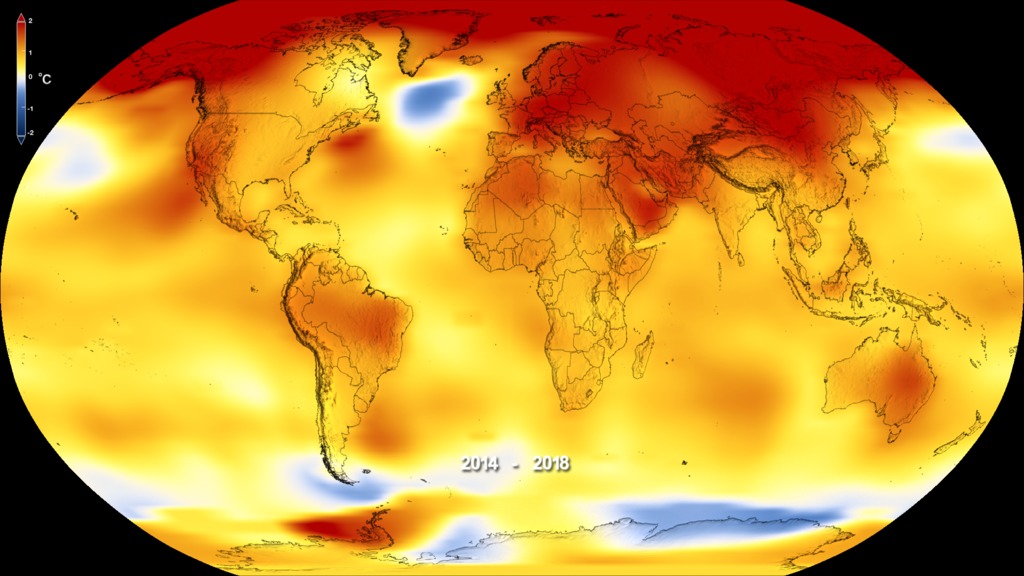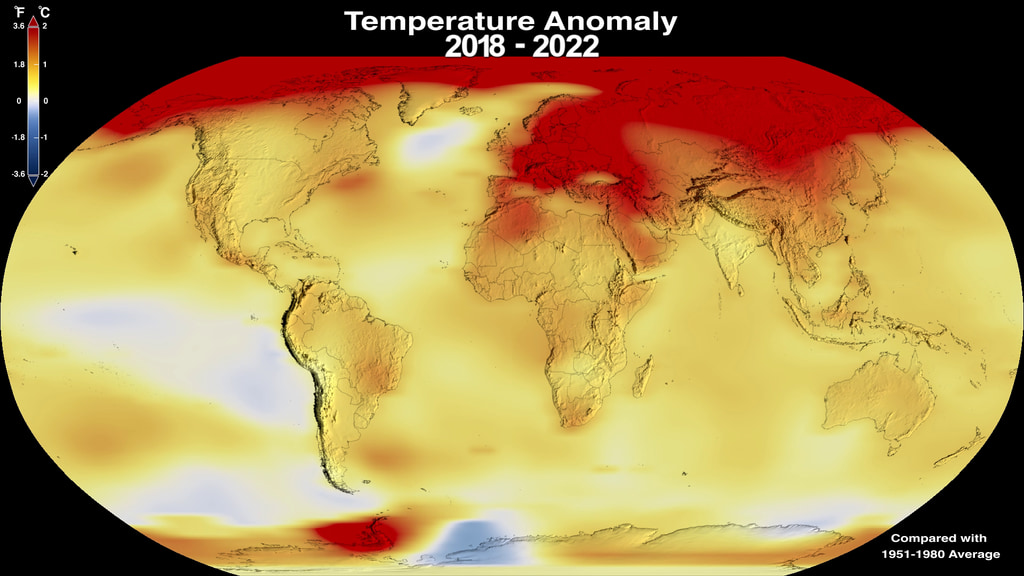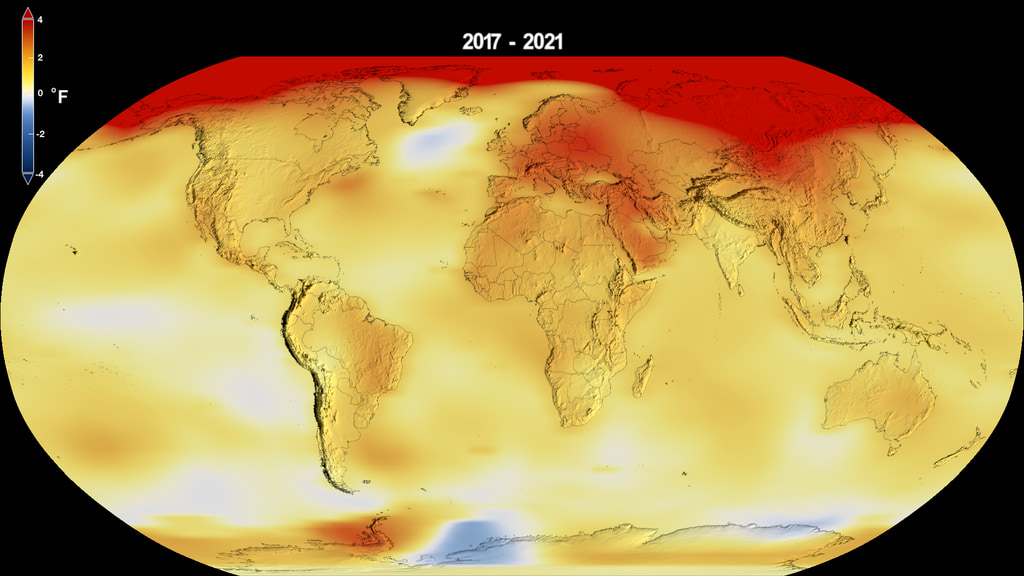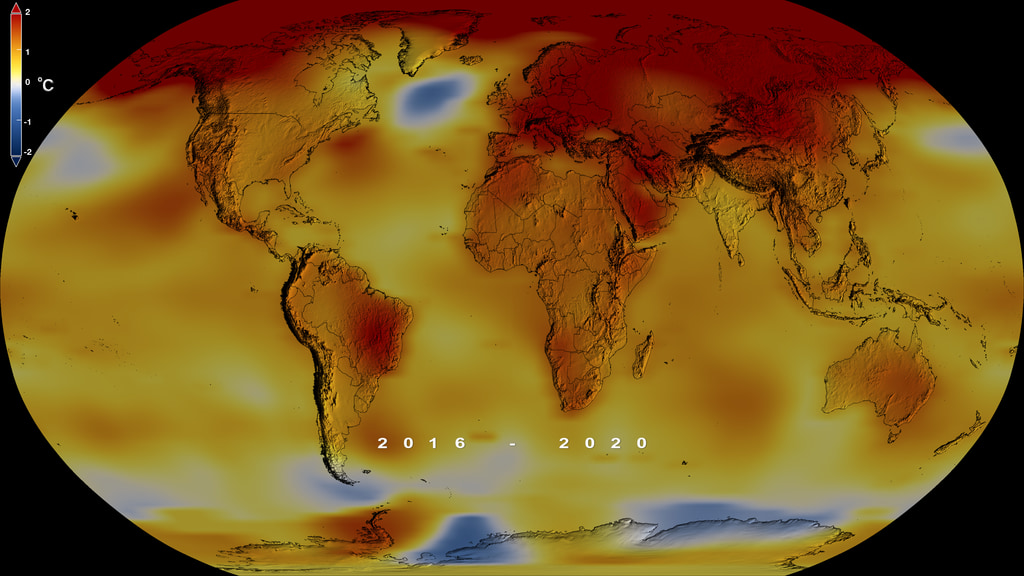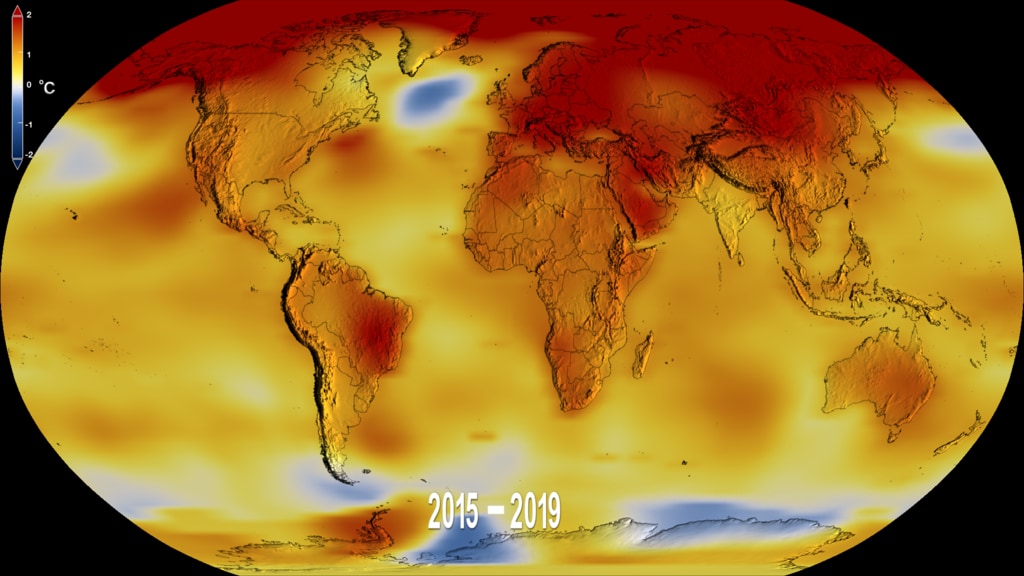A newer version of this visualization is available.
Five-Year Average Global Temperature Anomalies from 1880 to 2011
The global average surface temperature in 2011 was the ninth warmest since 1880.The finding sustains a trend that has seen the 21st century experience nine of the 10 warmest years in the modern meteorological record. NASA's Goddard Institute for Space Studies (GISS) in New York released an analysis of how temperatures around the globe in 2011 compared to the average global temperature from the mid-20th century. The comparison shows how Earth continues to experience higher temperatures than several decades ago. The average temperature around the globe in 2011 was 0.92 degrees F (0.51 C) higher than the mid-20th century baseline.
"We know the planet is absorbing more energy than it is emitting," said GISS director James E. Hansen. "So we are continuing to see a trend toward higher temperatures. Even with the cooling effects of a strong La Ni?a influence and low solar activity for the past several years, 2011 was one of the 10 warmest years on record."
The difference between 2011 and the warmest year in the GISS record (2010) is 0.22 degrees F (0.12 C). This underscores the emphasis scientists put on the long-term trend of global temperature rise as opposed to year-to-year variations. Because of the large natural variability of climate, scientists do not expect annual temperatures to rise consistently each year. However, they do expect a continuing temperature rise over decades. The first 11 years of the 21st century experienced notably higher temperatures compared to the middle and late 20th century, Hansen said.
For more information on the GISS temperature analysis, visit
This color-coded map displays a progression of changing global surface temperatures anomalies from 1880 through 2011. The final frame represents global temperature anomalies averaged from 2007 to 2011.
This visualization shows the same data as above with the corresponding date overlay applied. The final frame and the large still image represent global temperature anomalies averaged from 2007 to 2011.
This visualization shows the same data as above with the corresponding date and colorbar overlay applied.

Temperature difference colorbar.

This frame set and this movie of the five-year global temperature anomalies from 1880 through 2010 are made to be displayed on the Science On a Sphere display.

Global Temperature Anomalies averaged from 1890 to 1894.

Global Temperature Anomalies averaged from 1900 to 1904.

Global Temperature Anomalies averaged from 1910 to 1914.

Global Temperature Anomalies averaged from 1920 to 1924.

Global Temperature Anomalies averaged from 1930 to 1934.

Global Temperature Anomalies averaged from 1940 to 1944.

Global Temperature Anomalies averaged from 1950 to 1954.

Global Temperature Anomalies averaged from 1960 to 1964.

Global Temperature Anomalies averaged from 1970 to 1974.

Global Temperature Anomalies averaged from 1980 to 1984.

Global Temperature Anomalies averaged from 1990 to 1994.

Global Temperature Anomalies averaged from 2000 to 2004.
Global Temperature anomaly data from 1992 through 2011 rendered out at 3840 by 2160 resolution.
Credits
Please give credit for this item to:
NASA/Goddard Space Flight Center Scientific Visualization Studio
Data provided by Robert B. Schmunk (NASA/GSFC GISS)
-
Animator
- Lori Perkins (NASA/GSFC)
-
Scientists
- James Hansen (NASA/GSFC GISS)
- Reto A. Ruedy (SIGMA Space Partners, LLC.)
- Kwok-Wai Ken Lo (SIGMA Space Partners, LLC.)
- Makiko Sato (Columbia University, Center for Climate Systems Research)
- Robert B Schmunk (SIGMA Space Partners, LLC.)
-
Project support
- Robert B Schmunk (SIGMA Space Partners, LLC.)
-
Writer
- Patrick Lynch (Wyle Information Systems)
Release date
This page was originally published on Friday, January 20, 2012.
This page was last updated on Tuesday, November 14, 2023 at 12:01 AM EST.
Series
This visualization can be found in the following series:Papers used in this visualization
*Hansen, J., R. Ruedy, Mki. Sato, and K. Lo, 2010: Global surface temperature change. Rev. Geophys., 48, RG4004, doi:10.1029/2010RG000345.
Model documentation, including the ModelE specification and results from three standard configurations, is given in the following journal article:
* Schmidt, G.A., R. Ruedy, J.E. Hansen, I. Aleinov, N. Bell, M. Bauer, S. Bauer, B. Cairns, V. Canuto, Y. Cheng, A. Del Genio, G. Faluvegi, A.D. Friend, T.M. Hall, Y. Hu, M. Kelley, N.Y. Kiang, D. Koch, A.A. Lacis, J. Lerner, K.K. Lo, R.L. Miller, L. Nazarenko, V. Oinas, Ja. Perlwitz, Ju. Perlwitz, D. Rind, A. Romanou, G.L. Russell, Mki. Sato, D.T. Shindell, P.H. Stone, S. Sun, N. Tausnev, D. Thresher, and M.-S. Yao 2006. Present day atmospheric simulations using GISS ModelE: Comparison to in-situ, satellite and reanalysis data. J. Climate 19, 153-192.
Datasets used in this visualization
-
GISTEMP [GISS Surface Temperature Analysis (GISTEMP)]
ID: 585The GISS Surface Temperature Analysis version 4 (GISTEMP v4) is an estimate of global surface temperature change. Graphs and tables are updated around the middle of every month using current data files from NOAA GHCN v4 (meteorological stations) and ERSST v5 (ocean areas), combined as described in our publications Hansen et al. (2010) and Lenssen et al. (2019).
Credit: Lenssen, N., G. Schmidt, J. Hansen, M. Menne, A. Persin, R. Ruedy, and D. Zyss, 2019: Improvements in the GISTEMP uncertainty model. J. Geophys. Res. Atmos., 124, no. 12, 6307-6326, doi:10.1029/2018JD029522.
This dataset can be found at: https://data.giss.nasa.gov/gistemp/
See all pages that use this dataset
Note: While we identify the data sets used in these visualizations, we do not store any further details, nor the data sets themselves on our site.
